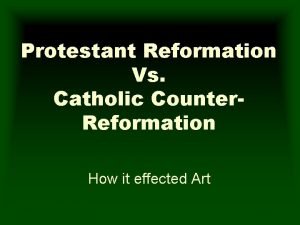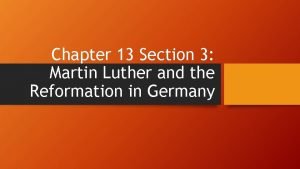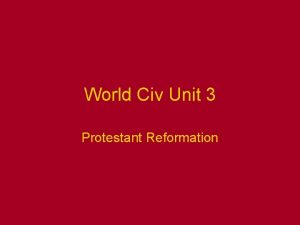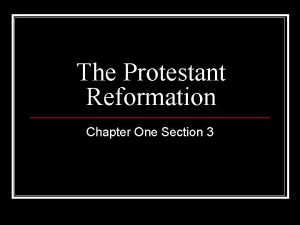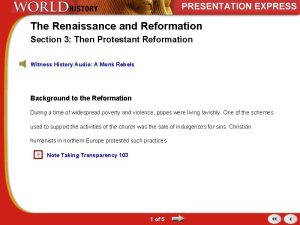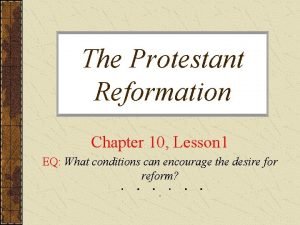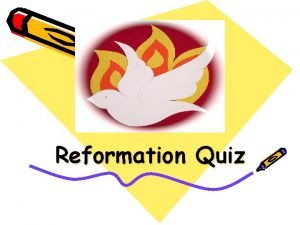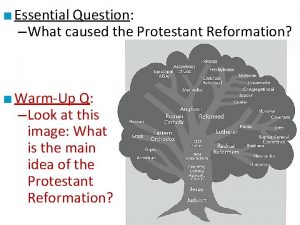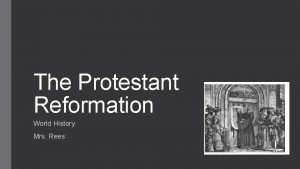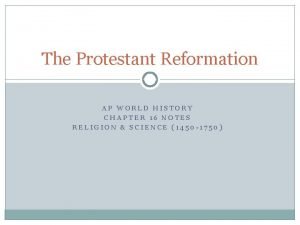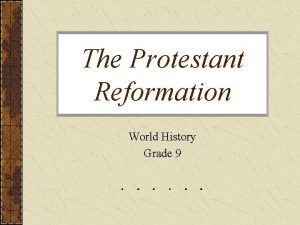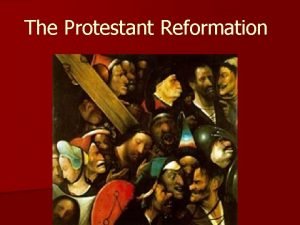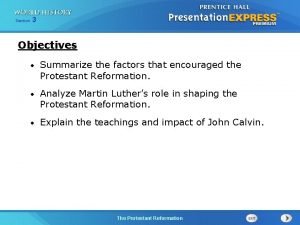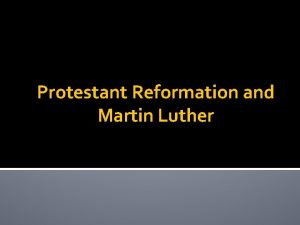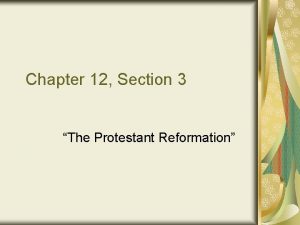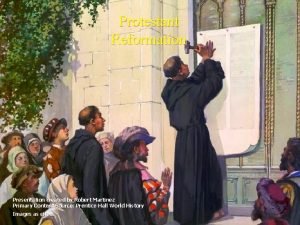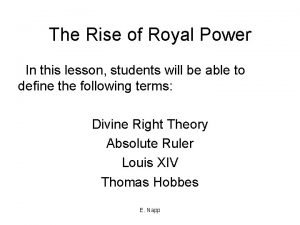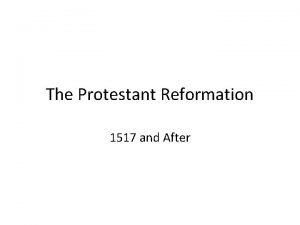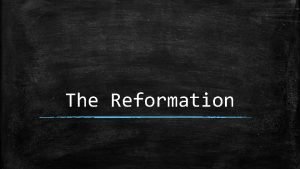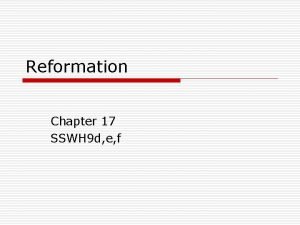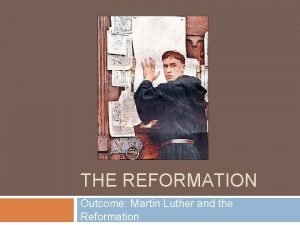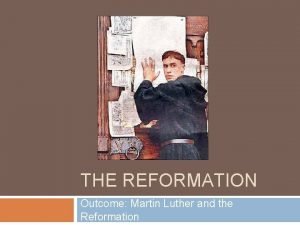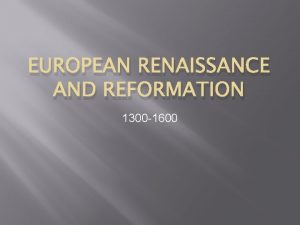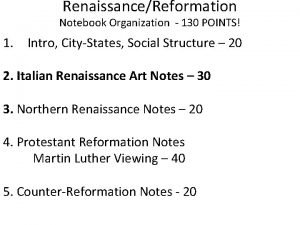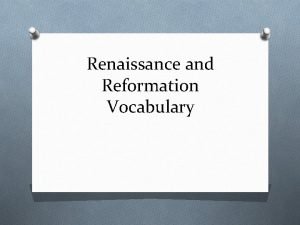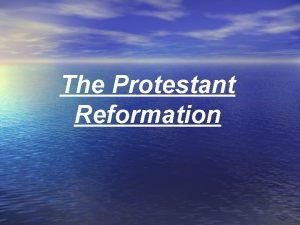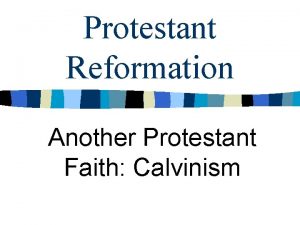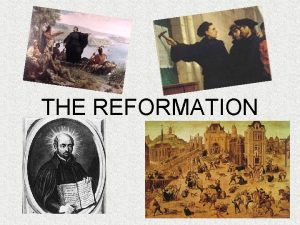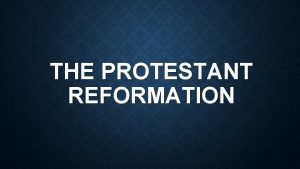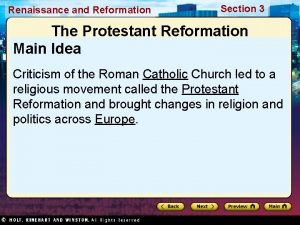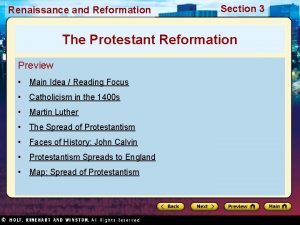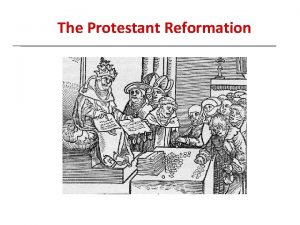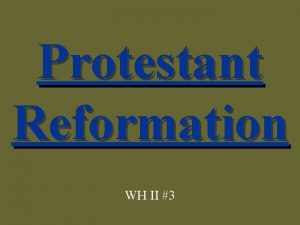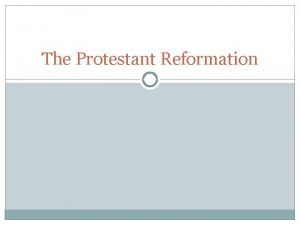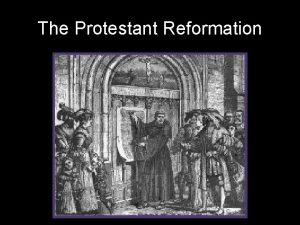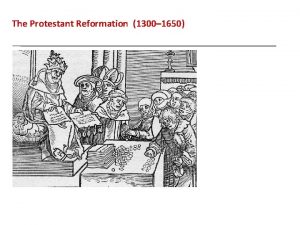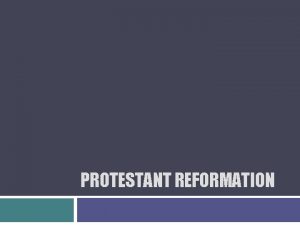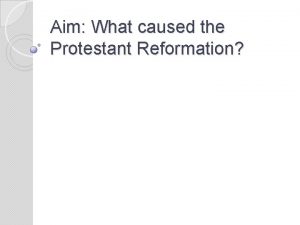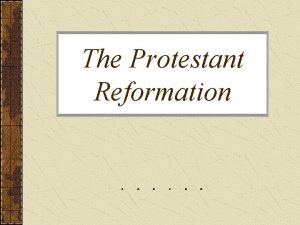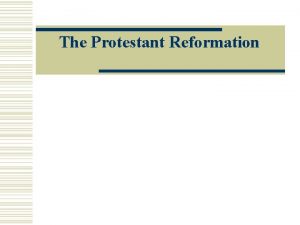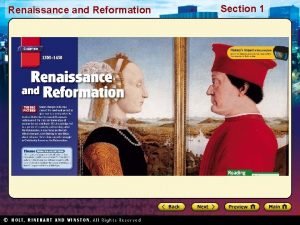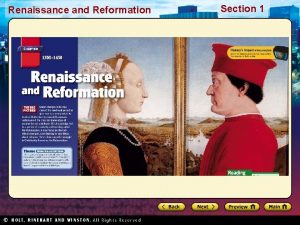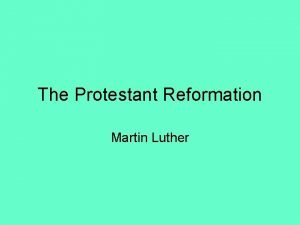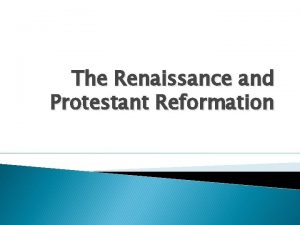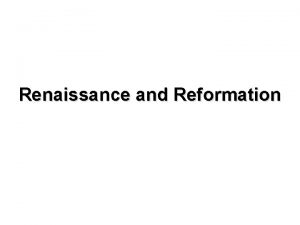Renaissance and Reformation Section 3 The Protestant Reformation


























- Slides: 26

Renaissance and Reformation Section 3 The Protestant Reformation Main Idea Criticism of the Roman Catholic Church led to a religious movement called the Protestant Reformation and brought changes in religion and politics across Europe. Reading Focus • What was the state of Catholicism in the 1400 s? • How did Martin Luther challenge the Catholic Church? • How did Protestantism spread to other areas? • What were the effects of the Reformation in England?

Renaissance and Reformation Section 3 The Heretic I was walking across a bridge one day, and I saw a man standing on the edge, about to jump off. So I ran over and said, "Stop! Don't do it!" "Why shouldn't I? " he said. I said, "Well, there's so much to live for!" He said, "Like what? " I said, "Well, are you religious or atheist? " He said, "Religious. " I said, "Me too! Are your Christian or Buddhist? " He said, "Christian. " I said, "Me too! Are you Catholic or Protestant? " He said, "Protestant. " I said, Me too! Are your Episcopalian or Baptist? He said, "Baptist!" I said, "Wow! Me too! Are your Baptist Church of God or Baptist Church of the Lord? He said, Baptist Church of God!" I said, "Me too! Are your Original Baptist Church of God or are you Reformed Baptist Church of God? " He said, "Reformed Baptist Church of God!" I said, "Me too! Are you Reformed Baptist Church of God, Reformation of 1879, or Reformed Baptist Church of God, Reformation of 1915? " He said, "Reformed Baptist Church of God, Reformation of 1915!" I said, "Die, heretic scum!" and pushed him off.

Renaissance and Reformation Section 3 Catholicism in the 1400 s Roman Catholic Church—influential, extravagant, and worldly Some people felt church straying from spiritual roots Concerns crystallized into the Protestant Reformation Dissatisfaction • Financial corruption, abuse of power, immorality • People’s respect for priests, monks, popes weakened • Heavy taxation also caused discontent Financing Basilica • Pope Leo X approved sale of indulgences • Needed money for St. Peter’s Basilica • Indulgences, pardons reduced a soul’s time in purgatory

Section 3 Renaissance and Reformation Catholicism in the 1400 s Working Off Sins • Catholics believed dead went to purgatory, worked off sins committed • Sale of indulgences widely criticized • Government separate from the church

Renaissance and Reformation Early Reformers John Wycliffe • Two men stepped forward to challenge the church • Englishman John Wycliffe believed church should give up earthly possessions • His views unpopular with church officials • Was removed from teaching position Section 3

Renaissance and Reformation Section 3

Renaissance and Reformation Section 3 JOHN WYCLIFFE, NOT WYCLEF JEAN

Section 3 Renaissance and Reformation Early Reformers John Wycliffe • Two men stepped forward to challenge the church • Englishman John Wycliffe believed church should give up earthly possessions • His views unpopular with church officials • Was removed from teaching position Jan Hus • From Bohemia, Jan Hus preached against immorality and worldliness of Catholic Church • Excommunicated by Pope Gregory XII; later arrested, tried for heresy and burned at stake • These influential theologians openly criticized church • Beginnings of discussions that eventually led to reform

Renaissance and Reformation Section 3

Renaissance and Reformation Section 3

Renaissance and Reformation Section 3 The Execution of Jan Hus • Hus was led away to the stake under a strong guard of armed men. At the place of execution he knelt down, spread out his hands, and prayed aloud. Some of the people asked that a confessor should be given to him, but one priest exclaimed that a heretic should neither be heard nor given a confessor. • The executioners undressed Hus and tied his hands behind his back with ropes, and bound his neck with a chain to a stake around which wood and straw had been piled up so that it covered him to the neck. At the last moment, the imperial marshal, Von Pappenheim, in the presence of the Count Palatine, asked him to recant and thus save his own life, but Hus declined with the words "God is my witness that the things charged against me I never preached. In the same truth of the Gospel which I have written, taught, and preached, drawing upon the sayings and positions of the holy doctors, I am ready to die today. "[5] He was then burned at the stake.

Renaissance and Reformation Section 3

Section 3 Renaissance and Reformation Martin Luther’s public criticism of the church in 1517 marks the symbolical beginning of the Protestant Reformation. The Ninety-Five Theses • Martin Luther believed selling indulgences sinful • In theses, said indulgences had no power to remit sin • Criticized power of pope, wealth of church • Theses written in Latin, intended for church leaders, not common people Stimulated Discussion • Nailing theses to church door common practice; doors used like community bulletin boards • Theses stimulated discussion among university intellectuals • Published, distributed across Europe, widely read by intellectuals, clergy, laypeople • Desire for reform grew

Renaissance and Reformation Section 3 Luther’s Message • Following publication of theses, Luther continued to study, debate • Contradicted basic Catholic beliefs, insisted God’s grace cannot be won by good works; faith alone needed • 1519, declared only head of Christian Church was Jesus, not pope Empowered the People • Insisted that individual Christians should be own interpreters of scripture, Christian practices should come only from Bible • To aid this process, Luther translated Bible into German • Translation allowed more people to read Bible without aid of clergy

Section 3 Renaissance and Reformation Reactions to Luther Church’s Response • 1520, Pope Leo X expelled Luther from the Church • 1521, Luther summoned to appear before Holy Roman emperor Charles V German Diet • Luther appeared before emperor, German Diet, or assembly, at city of Worms • Refused to change opinions

Renaissance and Reformation Section 3

Section 3 Renaissance and Reformation Reactions to Luther Church’s Response • 1520, Pope Leo X expelled Luther from the Church • 1521, Luther summoned to appear before Holy Roman emperor Charles V German Diet • Luther appeared before emperor, German Diet, or assembly, at city of Worms • Refused to change opinions Edict of Worms Protestant • Emperor handed down Edict of Worms • 1529, Charles V tried to suppress Lutherans in Germany • Declared Luther to be outlaw, condemned his writings • German princes issued protestatio, protest, against this • Luther’s ideas spread • Term Protestant came from this

Renaissance and Reformation Section 3 The Spread of Protestantism • • • Luther’s stand against the church opened the door for others Differing ideas on religious matters put forth. As Lutheranism arose in Germany, new religious movements began in Switzerland other places in Europe. Ulrich Zwingli • Born in Switzerland, entered priesthood at 22, preached ideas similar to Martin Luther’s • Many ideas viewed as radical • His church based on theocracy, government in which church, state joined; officials divinely inspired Opposed by Luther • Many supported Zwingli, others did not, including Luther • Luther accused Zwingli of tampering with word of God • Without Lutherans’ support, Swiss Protestants vulnerable to attack by Catholics When the disagreement between Swiss Protestants and Catholics erupted into war, Zwingli was a casualty. He died in battle in 1531.

Renaissance and Reformation Section 3

Renaissance and Reformation Section 3 John Calvin Background • John Calvin most important Protestant reformer next to Martin Luther • Educated in France, influenced by Erasmus, Renaissance humanists • Supported reforms of Luther in Germany Influenced by Augustine • Preached doctrine of predestination • God knows who will be saved, guides lives of those destined for salvation • Nothing humans can do, good or bad, will change predestined end People Sinful by Nature • Geneva became theocracy under Calvin; strict laws regulated behavior • Strictness at heart of Calvinism’s appeal, gave sense of mission, discipline • Calvinists making world fit for “elect” who had been chosen for salvation

Renaissance and Reformation Section 3 Protestantism Spreads to England • Protestant Reformation began with criticisms of the Catholic Church by priests and other religious thinkers. • Reformation began with the king in England A King’s Protest Annulment Opposition • 1509, Henry VIII became king, age 17 • Devout Catholic • Wrote angry protests against Luther’s ideas • Actions won him title “Defender of the Faith” • By 1525, Henry had only one child, Mary • Henry wanted male heir, thought female monarch would weaken England • Decided to have marriage to Catherine annulled • Pope would not agree to annulment • Catherine, nephew Holy Roman Emperor Charles V, also opposed annulment • Dilemma became “the king’s great matter” • Arguing with Pope, Henry fell in love with Anne Boleyn

Renaissance and Reformation HORRIBLE HISTORY!!!! Section 3

Renaissance and Reformation Section 3 The Reformation Parliament Henry Takes Over • Reformation Parliament declared that England no longer considered itself under authority of pope • Henry became head of Church of England • Henry changed rituals of church very little • Closed Catholic monasteries, convents, distributed much of land to nobles • This built more public support for split from Catholic Church Act of Supremacy • Anne Boleyn and Henry secretly married; marriage to Catherine annulled • Later that year Anne gave birth to daughter, Elizabeth • Act of Supremacy passed; Henry VIII “Supreme Head of Church of England”

Section 3 Renaissance and Reformation Henry’s Heirs • • Third wife, Jane Seymour gave England male heir, Edward VI 1547, Edward VI took throne, age 9 Protestantism gained more ground under guidance of his guardians Edward died young; sister, Mary became queen of England Bloody Mary • Mary returned England to authority of pope • Hundreds burned at state for Protestant beliefs, earning queen title “Bloody Mary” • Her death caused little grief • Half-sister Elizabeth became queen Elizabeth’s Reign • Elizabeth I, Protestant at heart • 1559, drafted new Supremacy Act, splitting England again from Rome • Catholics plotted to place Mary, Queen of Scots, on throne • Elizabeth persecuted Catholics, secured Church of England

Renaissance and Reformation Section 3

Renaissance and Reformation Section 3 Summarize What caused the Reformation to spread to England? Answer(s): the desire of Henry VIII to annul his marriage
 Protestants vs catholics
Protestants vs catholics Chapter 13 section 3 the protestant reformation
Chapter 13 section 3 the protestant reformation Unit 3: martin luther & the protestant reformation
Unit 3: martin luther & the protestant reformation The renaissance and reformation section 3 quiz answer key
The renaissance and reformation section 3 quiz answer key The renaissance and reformation section 3 quiz
The renaissance and reformation section 3 quiz Chapter 3 lesson 1 the protestant reformation
Chapter 3 lesson 1 the protestant reformation How did martin luther start the protestant reformation quiz
How did martin luther start the protestant reformation quiz What caused the protestant reformation?
What caused the protestant reformation? Reformation rap
Reformation rap Chapter 16 lesson 1 the protestant reformation
Chapter 16 lesson 1 the protestant reformation Crash course protestant reformation
Crash course protestant reformation The protestant reformation crossword puzzle
The protestant reformation crossword puzzle What factors encouraged the protestant reformation
What factors encouraged the protestant reformation Unit 3: martin luther & the protestant reformation
Unit 3: martin luther & the protestant reformation Protestant reformation political cartoon
Protestant reformation political cartoon Unit 12 lesson 3 the protestant reformation
Unit 12 lesson 3 the protestant reformation Protestant reformation
Protestant reformation Protestant reformation
Protestant reformation Protestant reformation map
Protestant reformation map Protestant reformation kahoot
Protestant reformation kahoot Peace of augsburg def
Peace of augsburg def The reformation outcome martin luther and the reformation
The reformation outcome martin luther and the reformation The reformation outcome martin luther and the reformation
The reformation outcome martin luther and the reformation European renaissance and reformation
European renaissance and reformation Topic 4 the renaissance and reformation
Topic 4 the renaissance and reformation Renaissance and reformation interactive notebook
Renaissance and reformation interactive notebook Renaissance and reformation vocabulary
Renaissance and reformation vocabulary
